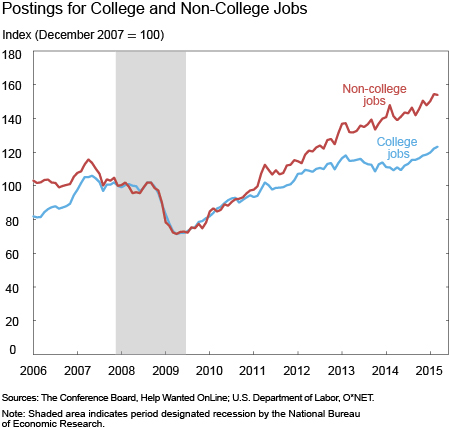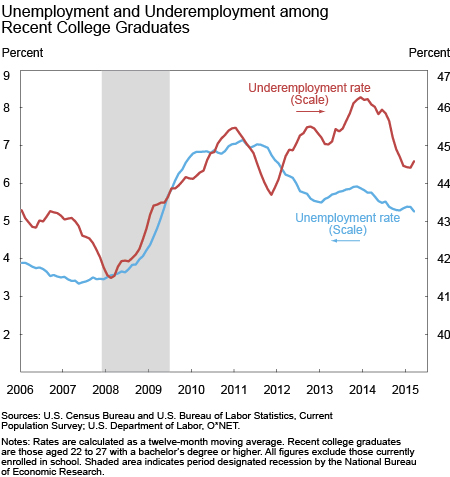With the college graduation season well under way, a new crop of freshly minted graduates is entering the job market and many bright young minds are hoping to land a good first job. It’s no wonder if they are approaching the job hunt with some trepidation. For a number of years now, recent college graduates have been struggling to find good jobs. However, the labor market for college graduates is improving. After declining for nearly two years, openings for jobs requiring a college degree have picked up since last summer. Not only has this increase in the demand for educated workers continued to push down the unemployment rate for recent graduates, but it has also finally started to help reduce underemployment, though the underemployment rate remains high. While successfully navigating the job market will likely remain a challenge, it appears that finding a good job has become just a little bit easier for the class of 2015.
The Demand for College Grads Is Increasing
To measure the demand for college graduates, we use the Help Wanted OnLine (HWOL) database of online job postings from the Conference Board. We classify postings into one of two categories based on the occupation code associated with each job opening: College jobs are those that typically require at least a bachelor’s degree, and non-college jobs are those that don’t (for more detail on the methodology used for this classification, see our article, “Are Recent College Graduates Finding Good Jobs?”). The trend in job postings for both types of jobs is shown in the chart below.

Although postings for college jobs and non-college jobs rebounded at roughly the same pace immediately following the Great Recession, by 2011 the demand for college graduates began to fall behind. In fact, postings for college jobs leveled off around 2013, and even declined slightly through mid-2014, while postings for non-college jobs continued to rise at a fairly steady clip throughout the recovery. Fortunately, the demand for college graduates started to pick up again last summer, rising by more than 10 percent through the first part of this year. This recent increase in the availability of college jobs has led to some improvement in labor market outcomes for young college graduates.
Rising Demand is Reducing Unemployment and Underemployment
The chart below shows both the unemployment rate and the underemployment rate (that is, the share of college graduates working in jobs that typically do not require a bachelor’s degree) for recent college graduates. Not surprisingly, both unemployment and underemployment rose sharply during the Great Recession and continued to climb in the early stages of the recovery.
The unemployment rate for recent college graduates began to fall in 2011, and it has continued to do so—with a hiatus during 2013—ever since. However, aside from a brief dip in early 2011, the underemployment rate continued to climb well into 2014, rising to a level of more than 46 percent. This divergence between falling unemployment and rising underemployment between mid-2011 and mid-2014 suggests that more college graduates were finding jobs during this time, just not necessarily good ones. The steady growth of non-college jobs, coupled with the relatively soft demand for college graduates during this three-year period, appears to have forced many recent college graduates to take jobs not commensurate with their education. More recently, though, the tide has turned. With the demand for college graduates rising at a solid clip since last summer, underemployment has also finally started to come down. Since last June, the underemployment rate for recent college graduates has fallen by about two percentage points, to 44.6 percent.
While these trends are no doubt good news for recent college graduates, it is important to keep the gains in perspective. As we have shown before in this post and this article, the underemployment rate for recent college graduates remains quite high by historical standards. At 44.6 percent, we estimate that nearly half of this group is working in jobs that typically do not require a college degree—a rate that is much higher than when underemployment hit a trough of around 38 percent in 2000. And while the demand for college graduates appears to be picking up, significant labor market slack remains, so continued strong growth in the demand for college graduates may well be necessary to make a more serious dent in the underemployment rate.
Disclaimer
The views expressed in this post are those of the authors and do not necessarily reflect the position of the Federal Reserve Bank of New York or the Federal Reserve System. Any errors or omissions are the responsibility of the authors.
 Jaison R. Abel is a research officer in the Federal Reserve Bank of New York’s Research and Statistics Group.
Jaison R. Abel is a research officer in the Federal Reserve Bank of New York’s Research and Statistics Group.
 Richard Deitz is an assistant vice president in the Bank’s Research and Statistics Group.
Richard Deitz is an assistant vice president in the Bank’s Research and Statistics Group.












 RSS Feed
RSS Feed Follow Liberty Street Economics
Follow Liberty Street Economics